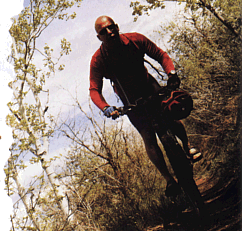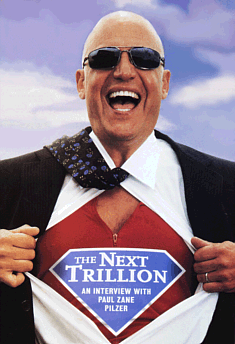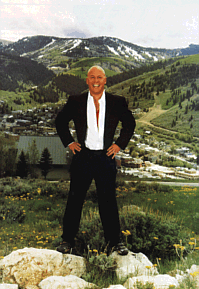Life Plus International Distributor / Associate
Training - homepage
|
| As I carefully studied current conditions, I found that the greatest need in America today is wellness. This is such a new need that the word itself, in the context we're using it, is an entirely a new term. |
Where do you learn about that one? Nowhere - that's what's missing, that's the bottleneck in our economy. Talk to any manufacturer and he'll tell you, "We're selling models A, B, C, and D; the new model F, is seven times better, it's even better priced - but nobody's buying it yet!" Why aren't they? Because they haven't learned about it yet. They call this "backlog."
I saw this with some educational software we developed in the early 90s: here was a product that could totally change a child's life - but telling people about it was far more expensive than producing it. Until we found the Amway Corporation in the mid 90s, we were pretty much dead in the water: we had great new products, but no way of telling the consumer they existed.
Q: How does network marketing's way of doing that contrast with more conventional ways of marketing - through advertising and other mass channels?
Network marketing today is almost wholly intellectual distribution. When you as a network marketer discuss a product with a consumer, you don't actually hand over the product. You rely on UPS or some other delivery service to have the product shipped to your consumer.
Even more fascinating is that network marketing today is typically done person-to-person by someone who is also the user of the product. Unlike the car salesman, electronics salesperson, or clothing salesperson, the network marketer is an educated, enthusiastic, experienced user of the product you're asking about.
Those companies that prosper in network marketing will focus almost entirely on intellectual distribution, teaching people about new products and services that will improve their lives. Those that really flourish will have some sort of unique or proprietary technology. And not just unique, but efficacious - better than anything else out there.
Q: So you've seen the weight of opportunity shift from manufacturing, to physical distribution, and now to intellectual distribution. How else has your own thinking changed? What is the focus of The Next Trillion?
I started to focus on the great needs of America - which led me in some surprising directions. People think of their needs in a very mundane way - "I need a new dress that doesn't make me look overweight.", or "I need a car that gets better mileage." I looked at it on a more macro level: we have more fundamental needs such as eating, sleeping, being healthy, being educated. As I carefully studied current conditions, I found that the greatest need in America today is wellness.
Q: Can you define "wellness" for us?
This is such a new need that the word itself, in the context we're using it, is an entirely new term. I had to come up with entirely new definitions. First I had to realize that what we call the "healthcare" business is really the sickness business. Our medical industry today has very little, if anything, to do with health. The $1.4 trillion we spend on medical care, which is one seventh of the U.S. economy, is concerned with being sick and treating symptoms of sickness. It has very little to do with preventing illness, with being stronger or healthier. When you go to people in the medical industry today and say, "I have arthritis, I don't see as well, I don't hear as well." They say, "It's because of age - age, age, age, age." But these are really just symptoms of poor nutrition.

| What we call the "health care" business is really the sickness business. The $1.4 trillion we spend on medical care is concerned with treating the symptoms of sickness. It has very little to do with preventing illness, with being stronger or healthier. |
I define "wellness" as money spent to make you feel healthier, even when you're not "sick" by any standard medical terms. To make you stronger, to make you see better, to make you hear better, to fight what we might call the symptoms of aging.
Walk into any average home in any average neighborhood, talk to them, see what they need. If we were doing this 20 years ago, we'd find that most of them were worried about making a living, about their new job, about what professions their children should go into. The primary need for Americans in our first 200 years was economic. That's no longer true.
Today we are in the eleventh or twelfth year of an unbelievable economic expansion. Here is what you find today as you walk into each home: They have enough to eat, they overwhelmingly know where their economic opportunities are, they know what they could be doing to make more money, and if they're not, it's often by positive choice - for example, because they want to spend more time with their families. the overall primary need today is not their wealth - it's their health.
In the past we've associated poverty and economic depression with ill health. When I was young, we often equated " poor" with thin, starving. "Thin rich man" was an oxymoron. Today, "poor" and "fat" have become synonymous. The tables have turned: "rich fat man" has become an oxymoron!

| In the past, we've associated poverty and economic depression with ill health. When I was young, we often equated "poor" with thin, starving. "Thin rich man" was an oxymoron. Today, "poor" and "fat" have become synonymous. The tables have turned: "rich fat man" has become an oxymoron! |
Today, the lower the income, the more we see obesity. Obesity is a symptom of poor nutrition. Typically someone who is obese is also vitamin-deficient, suffers from fatigue and arthritis or other ailments that all stem from poor nutrition.
Since 1980, we have more than doubled the percentage of overweight and obese people in our country. In 1980, 15 percent of the population was obese; by the year 2000 that number had jumped to 27 percent-that's 77 million clinically obese people! Those numbers have increased ten percent in just the past four years and are still growing at beyond epidemic rates.
Because of people being overweight or obese, we've also tripled the propensity to get diabetes in this country, with similar increases in so many other diseases. Today, at a time of unprecedented economic prosperity, we're seeing a huge part of our population falling off the edge. For me, here is the most amazing number: 61 percent of the United States population is overweight. That number, too, has doubled since 1980.
Now, how did we win the Cold War and become so prosperous - only to end up in a world where 61 percent of the population is as oppressed as if the Russians had won the Cold War?
Q: Is there a ray of sunshine here?
More than a ray; in fact, as grisly as this situation is, it has also given rise to an entirely new economic sector, a very positive sector - which is where I got the title The Next Trillion.
Q: Why do you call this the "next" trillion?
Today, the food industry represents about one trillion dollars annually; the "sickness business" is another trillion (actually, about $1.4 trillion). These two industries feed one another in a fairly insidious way because such a huge part of sickness today is caused by the poor nutrition supplied by the food industry. These two trillion-dollar industries work together to support that horrifying 61 percent overweight number.
Looking at those numbers, you might think that one day soon, everyone will b e overweight or obese. That's actually not the case, though. The 39 percent of the U.S. population who are not overweight comprise 10 to 15 million Americans who are aging; as they age, they are getting more healthy, more fit, more strong - actually younger, by any standard medical definition.
These people represent that new economic sector. They are primarily wealthy people; the first thing they do as they start to have money is to figure out how they can be healthier - and they're doing it outside the medical establishment. They are going to fitness clubs, watching their food, taking the proper amounts of vitamins and minerals, and investigating supplements and other products that support their wellness.
When I began to see this trend clearly, I started wondering , is there is a business here? The answer stunned me.
In the year 2000, wellness in America was already a $200 billion industry; about half of that is composed of the $24 billion spent on fitness clubs plus the $70 billion spent on vitamins and minerals. This $200 billion was hardly a blip ten years ago.
Q: Who is spending this Money?
Mostly Baby Boomers: prosperous people from the ages of 35 to 55. The Baby Boomers are a powerful economic force; all marketers know that. Baby Boomers represent only 28 percent of our population - yet the group represents 50 percent of our economy.
Baby Boomers are the first generation we know of in recorded history who refuse to accept the aging process. This is fascinating, from a marketing standpoint. Look at the cars they buy: they're retro, designed to make them look like they're in high school. Look at the clothes they buy; they're retro, too - they look like the clothes they wanted but couldn't afford to but in high school.
Up until now, the Baby Boomer marketing mind has been all about how to make them feel younger, how to help them remember what it was like to be young. Now it's gone a step further. Today, Boomers are starting to buy things that actually make them younger!
This has only just begun. Most people don't even know there are such products. As the rest of this 50 percent buying power group learn about wellness, this sector will explode. It has already gone from virtually zero in 1990 to $200 billion today. It's easy to see that this $200 billion will become one trillion - or more - by the year 2010.
Q: Do you get reactions, people saying, "What-a trillion dollars?!"
Oh, all the time. But put it in perspective. The first IBM PC came out in 1981 - and by 1990, PC sales exceeded automobile sales. Nobody knew what the Internet was in 1990; consumers were allowed to get on the Internet with their own accounts and private email addresses only in 1995. By 2000, the overwhelming amount of new wealth and new millionaires in this country were being created by the Internet. Given how fast these new industries grow, one trillion in wellness by the year 2010 starts to look like a conservative projection.

| As much as we focus on the financial and lifestyle benefits of the business, the real benefit is what you can do to change a life - and the lives of all the people who are touched by that life. |
Q: Does that same challenge of the bottleneck, the need for intellectual distribution, apply to the wellness industry, too?
Absolutely. By definition, all of wellness is new technology. There is virtually no place to go learn about it. If you go to conventional weight loss clinic, they are focused on marketing their processed food products to you - they don't give you lessons in wellness. The information just isn't out there; all the research in the medical business is on sickness. Where does the consumer turn?
The only way to learn about wellness is through someone close to you who has had a wellness experience. You see your college roommate and go, "My God, John, you look great! You look so healthy - what did you do?" You bump into a wellness experience and start to find out that there is a whole wellness industry out there, with all sorts of new products and services.
I went every year to an orthopedic surgeon about my knee. Each year he'd tell me, "Its worse than last year, you've gotta have an operation, Paul." At some point, I started taking glucosamine. Within two months, the pain was gone. I went back to check up with my orthopedist; he couldn't believe it. When he found out that all I'd done was take glucosamine, he said-jokingly, but also truthfully - "Don't spread this around, Paul...I'll be out of business."
Now, how could it be that a product like glucosamine, a natural substance which has been around for 50 years (primarily as a veterinary product for horses), a product that rebuilds my cartilage and makes me feel so good...how could it be that nobody knows about it? That's the classic introduction to wellness: typically, you have one experience like that, then you say, what else might there be that my doctor never told me about?
This experience set me on the path of learning about supplements, vitamins, and minerals. In my research for writing this book, I was amazed at how much basic biology and nutrition had escaped my education. Here I am, a college professor for 20 years, three times New York Times best-selling author - and I had been frankly oblivious about food, nutrition, vitamins, minerals, and natural supplements. That set me on this path of inquiry.
You couldn't really have gone into wellness 10 or 15 years ago because there was no wellness industry. Most of these products and services are just now coming out of the laboratory. And when you look into those laboratories and see what's coming, you see that this business is really going to take off. Of anything I've ever been involved with, the wellness industry looks the most exciting right now.
Q: What connection do you see between network marketing and this wellness revolution?
It's all about the difference between what I call "active learning" versus "passive learning." Conventional advertising media are not effective at delivering what they call "intellectually challenging" information-which is euphemism for "new ideas."
Think for a minute about how you watch TV. You're sitting back, you're relaxed, on your couch; the last thing you want is to be challenged with new information. In fact, when you do see something that challenges you, something that disagrees with what you already know or think is true, what do you do?
Q: You change the channel.
Right! Television is a very passive medium for learning, so we can't really use it to teach new ideas. It's the same with news papers. I used to write op-eds regularly for various newspapers such as The New York Times. I'd be at a cocktail party, excited about a piece I'd written, and ask a friend, "So, what'd you think about my piece on such and such?" He'd say, "Paul, I don't read your stuff. I'm a Democrat!" We don't read the op-ed pieces that challenge us. We read the ones that reinforce what we already think.
Most of our information sources today have become passive media. You don't spend time with them to be challenged; when you do encounter something that challenges you, you change the station or read the other column.
The only time you learn actively, meaning that you actually start taking in and considering new information, is when you start talking with someone in a real-life dialogue. First, the person says something you don't agree with. You think, "oh, that couldn't be true." Perhaps you don't say anything, because you're being polite-but your face gives away the fact that you don't agree. This starts a dialogue: they come back with a little more, you start to respond...gradually, bit by bit, the dialogue changes your mind.
Correct information about diet, nutrition, vitamins, minerals, and supplements is almost all contrary to what we've heard from our medical community; for many, it runs counter to how we were brought up. There's so much inaccurate information, naturally they're going to be skeptical. The only way they will actually change their paradigm or start to learn new information is person to person - because they're actively engaged in a conversation.
This doesn't happen overnight. It may take three, four, five, or six conversations with different people before your actually change your mind. That's why wellness, which is so clearly paradigm - changing information for so many people, really works best in a one-to-one interactive environment - like network marketing.
Q: What do you see for the decade ahead, Paul?
I see a one trillion dollar wellness industry by the year 2010. I see great opportunities for network marketing and network marketers. I see certain network marketing companies, because they're the fastest way to get the new information out there, leading that industry. I see great opportunities coming for the network marketing industry because network marketing is clearly the best vehicle we have today, in the United States and around the world, to educate people about new products and services. There's a great window of opportunity for network marketing companies to educate consumers about wellness products and services. I also see great challenges ahead for successful network marketing companies, particularly those involved in wellness, as the technology continues to evolve. Network marketing companies need to remain flexible so they can stay ahead of new technology. the best wellness products and services of yesterday may not be the best products and services tomorrow.
The personal computer industry is an apt analogy; entire companies have come and gone because they made, say, the best fax software-until someone came up with a better fax software, or because they made the best high-end monitor card - until every computer started coming with a high-end monitor card already built in.
Many of today's network marketing products will go to retail fairly quickly. You're already seeing that with glucosamine and a number of other supplements: they're starting to get into the conventional retail channels. To stay competitive, network marketers are going to have to stay ahead of the new technology.
I see consolidation in the industry. Many of the smaller network marketing companies will not have enough money for the R&D they need to compete with the new technologies. I see merging of companies, as well as companies enlarging their product offerings. Companies who can serve more of their customers' needs will be the most successful.
I see real clinical trials. The products of the wellness business are moving toward an era of greater quality control. Today, a third to a half of the bottles in retail stores do not have in them what is on the labels because it's not a regulated business. The company whose sole business is wellness has a lot more to lose if they make a mistake: they often have better quality control. Ultimately, none of the successful wellness companies can afford to have a bad quality product out there.

| Make no mistake there is a crisis, a trend of epidemic proportions going in the other direction in the rest of America. Right now, network marketing is the only force I see on the horizon that has the potential to make this kind of huge change. |
Q: As a part-time rabbi and someone who has been vegetarian (as you say in your book, for spiritual reasons), you've become pretty passionate about wellness, haven't you?
It has become something of a mission for me, and I think it is for network marketers as well. As much as we focus on the financial and lifestyle benefits of the business, the real benefit is what you can do to change a life-and the lives of all the people who are touched by that life. If you can add five, ten, fifteen years to someone's life, think of his children, think of his spouse. We're wonderfully interrelated in the world today, and when you can give someone the gift of wellness, improving the quality of that life every day and increasing the length of that life, it's a truly wonderful thing.
Make no mistake: there is a crisis, a trend of epidemic proportions going in the other direction in the rest of America. Right now, network marketing is the only force I see on the horizon that has the potential to make this kind of huge change.
This article
originally appeared in the September 2001 edition of Network Marketing
Lifestyles Magazine.

 Now
he's back, with a new message: We are witnessing the explosive birth of a new
trillion-dollar industry, and network marketers everywhere are poised to be the
vanguard of that explosion.
Now
he's back, with a new message: We are witnessing the explosive birth of a new
trillion-dollar industry, and network marketers everywhere are poised to be the
vanguard of that explosion.
